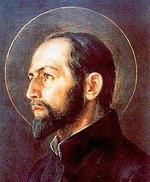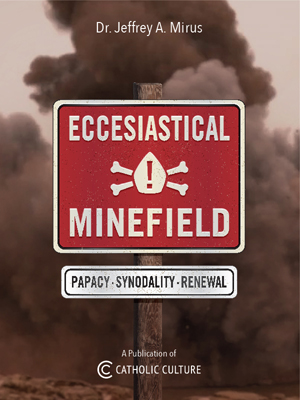Traditional Catholic Scholars Long Opposed Fr. Brown's Theories
While Roger Cardinal Mahony of Los Angeles, Bishop Donald W. Trautman of Erie, Pa., and others were effusive in their praise of the late modernist Scripture scholar Fr. Raymond E. Brown, S.S., for pre-eminence in his field, it's a matter of record that traditional Catholic biblical scholars have always presented a far different perspective on him.
Fr. Brown, author of 25 full-length books on the Bible and professor emeritus at the Protestant Union Theological Seminary where he taught for 23 years, died August 8th at age 70. Cardinal Mahony hailed him as "the most distinguished and renowned Catholic biblical scholar to emerge in this country ever" and his death, the cardinal said, was "a great loss to the Church."
Archbishop William J. Levada of San Francisco, with Cardinal Mahony at his side, celebrated a memorial Mass in the Chapel of St. Patrick in Menlo Park, Calif., where the priest-scholar lived in retirement. Soon after, another high churchman, William Cardinal Keeler of Baltimore, celebrated Fr. Brown's funeral Mass at the Sulpician Seminary in Catonsville, Md., where burial also took place.
But despite countless honors and accolades — Brown received 24 honorary degrees, many from Protestant institutions — Fr. Brown drew sharp criticism from the late Lawrence Cardinal Shehan and others for his pioneering role "in a new Catholic theology founded on modern exegesis" that cast doubt on the historical accuracy of numerous articles of the Catholic faith.
These articles of faith, proclaimed by Popes and believed by the faithful over the centuries, include Jesus' physical Resurrection; the Transfiguration; the fact that Jesus founded the one, true Catholic Church and instituted the priesthood and the episcopacy; the fact that 12 Apostles were missionaries and bishops; and the truth that Jesus was not "ignorant" on a number of matters.
Not least, though, was Fr. Brown's exegesis concerning the infancy narratives of Saints Matthew and Luke that calls into question the virginal conception of Jesus and the accounts of our Lord's birth and childhood.
In addition to Cardinal Shehan, such eminent peers of Fr. Brown as Msgr. George A. Kelly, Fr. William Most, Fr. Richard Gilsdorf, Fr. Rene Laurentin, and John J. Mulloy were highly critical of the Brown revisionism of the Catholic Church's age-old theology of inspiration and inerrancy.
"A Slender Basis"
In point of fact, Fr. Brown in his first Union Theological Seminary lecture, in 1971, sounded a well-publicized call for "a scholarly reassessment" of the historical accuracy of Jesus' conception and virginal birth.
Specifically, in his book Biblical Exegesis and Church Doctrine (1985), Fr. Brown again put the Virgin Birth — a central dogma of the Catholic faith — in the category of "doctrines for which there is slender basis in Scripture."
Such was Fr. Brown's reputation and his influence as a pioneer in modernist Scripture scholarship that many Catholic "biblical scholars" followed his lead. Some of them took more "far-out" positions than Fr. Brown himself, charging that a number of New Testament revelations, especially those related to Saints Matthew's, and Luke's infancy narratives, were mythological, just nice stories to underscore a certain truth.
Fr. Brown and many of those Catholic exegetes who followed him hold that it is "very uncertain" that angels appeared to Mary and Joseph; that there appeared a star interpreted by magi from the east as a sign of the birth of the King of the Jews, and that they followed it to Bethlehem; that angels appeared to the shepherds; and that Mary and Joseph lived in Nazareth.
Also on the Raymond Brown "doubtful list" was that Herod learned about Jesus' birth and then ordered the slaughter of children in Bethlehem, and that Joseph, Mary, and Jesus fled to Egypt to escape slaughter. And, as Marian scholar Gerard Morrissey, author of The Hardest Cross: Doctrine and Vatican Policy, pointed out recently, if anyone doubts all that, he must also doubt St. Luke's four canticles — the Magnificat, the Benedictus, the Nunc Dimittis (Simeon's words at the Presentation), and the Gloria in Excelsis.
Morrissey in his soon-to-be-published book. For the Love of Mary: Defending the Church from Anti-Marianism, devotes several chapters to an examination of Fr. Brown's mythological anti-Marianism with its obvious implications. He notes, for example, that if the Angel Gabriel never appeared to Mary at the Annunciation, the beautiful words of the Hail Mary, "Hail Mary, full of grace, the Lord is with thee," were never spoken. Further, if the Blessed Virgin received no word from the Angel Gabriel, she could never have said in reply: "Behold the handmaid of the Lord, be it done unto me according to thy word."
To protect himself lest he be accused of a denial of the Virgin Birth, Fr. Brown asserted artfully that he accepted the dogma because the Catholic Church teaches it, even though "the Church through its official teachers has made the decision that a minority New Testament view, however scarcely attested, was a true evaluation of what God did in Jesus."
Nevertheless, Fr. Brown, in writing, teaching, and lecturing that resonated in schools and colleges, in seminaries, in pulpits, and in many chanceries, insisted that "the scientific controlled evidence derived from a study of the New Testament left the historicity of the virginal conception unresolved."
A Rebuttal
Morrissey tells us that Fr. Brown, while believing that "it is likely that Matthew and Luke teach the Virgin Birth," also asserts that the Virgin Birth is only a "minority view in the New Testament." Why? Because other books of the New Testament, for example, the Gospel of Mark, make no mention of the Virgin Birth.
To this, Morrissey offers a well-reasoned rebuttal for Catholics troubled by Brown's reasoning:
"Suppose a family member suddenly takes seriously ill. Nearby is a doctor's office. So we ask Raymond, a family member, to go for the doctor. Before leaving, Raymond tells us: 'Our family believes that this man has a special knowledge of medicine. Since the family believes this, and I want to be loyal, I believe it also.
" 'However, I'm not sure that this man is a licensed doctor. Perhaps he is, but it's possible he is not. Yes, he has two plaques on his office wall. One says he graduated with honors from Harvard Medical School. The second plaque says he was licensed five years ago to practice medicine in our state. But, perhaps these statements are not historically true: they may be a literary device by which the man is communicating an important truth — that he is interested in helping sick people.
" 'One reason we have to doubt whether this man is a licensed doctor is that none of the other tenants in the building has a plaque on the wall supporting such a claim. The silence of other tenants means that either they deny that he is a doctor, or that they are ignorant of the fact. In other words, it is only a minority view within his own building that he is licensed. Would such denial or ignorance by fellow tenants be possible if the man were really what his plaques claim?"'
The rest of the family, Morrissey stated, would logically respond to Raymond as follows:
• "The reason our family is convinced the man has special knowledge of medicine is precisely the fact that he claims to be a licensed doctor who graduated from Harvard Medical School."
• "If the claims made by the plaques in his office are not historically true, then the man is a liar and a fraud — and our family would not go to him."
• "The 'silence' of the other tenants does not mean that this is only a 'minority view' in the man's own building that he is a licensed doctor. If anything, such silence indicates that the rest of the tenants accept the man's claim — since if they do not, at least some of the tenants would have made a statement or taken some action to warn the unsuspecting public."
Pertaining to the defined dogma of the Virgin Birth of Jesus, Pope John Paul II, writing after Fr. Brown and the others set forth their arguments, officially rejected their position in July, 1996 when he stated:
"The uniform Gospel witness testifies how faith in the virginal conception of Jesus was firmly rooted in the various milieux of the early Church. This deprives of any foundation several recent interpretations which understand the virginal conception not in a physical or biological sense, but only as symbolic or metaphorical: it would designate Jesus as God's gift to humanity. The same can be said for the opinion advanced by others, that the account of the virginal conception would instead be a theolo-goumenon, that is, a way of expressing a theological doctrine, that of Jesus' divine sonship, or would be a mythological portrayal of Him.
"As we have seen, the Gospels contain the explicit affirmation of a virginal conception of the biological order, brought about by the Holy Spirit. The Church made this truth her own, beginning with the very first formulations of the faith.
"The faith represented in the Gospels is confirmed without interruption in later Tradition. The formulas of faith of the first Christian writers presuppose the assertion of virginal birth, a real, historical virginal conception of Jesus. . . . The solemn definitions of faith by the ecumenical councils and the papal Magisterium, which follow the first brief formulas of faith, are in perfect harmony with this truth."
A Befogged Wasteland
St. John's University professor emeritus Msgr. Kelly in his The Church's Problem With Biblical Scholars declares that when Fr. Brown questions the doctrine of the virginal conception, "and says what he earlier called infallible, is really fallible, after all," Brown leaves his audience, if not himself, "in a squirrel cage running round and round in a circle always returning to the same place, doubt."
Msgr. Kelly stated that the new modernist proposals are often only theories which contradict understandings from the earliest Christian days.
Scripture scholar Fr. Gilsdorf, whose excellent two-part series in The Wanderer some years ago commenting on Fr. Brown's book, 101 Questions on the Bible, debunked many of Brown's theories, including his concept of "an ignorant Jesus," urges that before reading Fr. Brown, Catholics should forearm themselves by an open-minded reading of orthodox critics of Brown.
"Begin with Msgr. Kelly, then Cardinal Shehan, Fr. Miguens, Fr. Most, and Fr. Laurentin," Fr. Gilsdorf says.
Concerning Fr. Brown, Fr. Gilsdorf asked these telling questions: "Is Fr. Brown right? How much can we rely on his teaching? Are his claims to orthodoxy valid? Is he a safe guide, or, as I would judge, a major contribution to the befogged wasteland of an 'American Church,' progressively alienated from its divinely constituted center?" © The Wanderer, 201 Ohio Street, St. Paul, MN 55107, 612-224-5733.
This item 525 digitally provided courtesy of CatholicCulture.org






